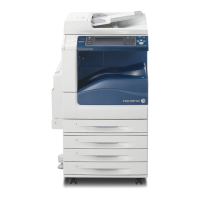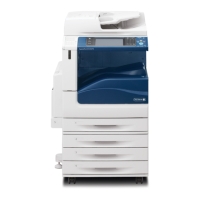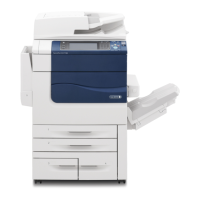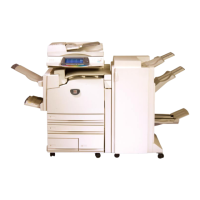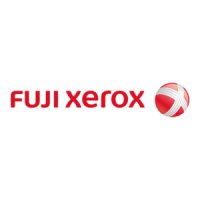
Do you have a question about the Fuji Xerox ApeosPort-IV C4475 and is the answer not in the manual?
| Functions | Print, Copy, Scan, Fax |
|---|---|
| Print Speed (Color) | 45 ppm |
| Print Speed (Monochrome) | 45 ppm |
| Print Resolution | 1200 x 2400 dpi |
| Duplex Printing | Yes |
| Scan Resolution | 600 x 600 dpi |
| Copy Resolution | 600 x 600 dpi |
| Fax Speed | 33.6 kbps |
| Connectivity | Ethernet |
| Scanner Type | Duplex ADF |
| Scan Speed | 70 ipm (mono), 70 ipm (color) |
| Display | 10.1-inch color touchscreen |
| Paper Size | A3, A5 |
| Ethernet | Yes |
| Copy Speed (Black/White) | 45 cpm |
| Copy Speed (Color) | 45 cpm |
| Network Connectivity | Ethernet |
| Operating System Compatibility | Windows |
Introduction to the user guide and its purpose, assuming basic computer knowledge.
Lists and describes accompanying manuals and guides for optional components.
Explains the intended users and structure of the guide, detailing each chapter.
Provides warnings and symbols for safe handling and operation of the machine.
Covers radio frequency emissions, RFID information, and product safety certifications.
Details Fuji Xerox's approach to toner/drum cartridges and proper disposal.
Describes software licenses, including RSA BSAFE, Heimdal, JPEG Code, and Libcurl.
Warns about illegal copying of documents and lists examples of prohibited items.
Describes the various components of the machine and their functions, including feeders and finishers.
Explains the power switch and main power switch for operating the machine.
Describes the function of the circuit breaker and how to check its proper operation.
Explains the Low Power and Sleep modes to save electricity when the machine is not in use.
Details the names and functions of components on the control panel.
Describes the [Services Home] screen, its fields, and available services.
Explains how to use the on-screen keyboard for text entry, including symbols and deletion.
Provides instructions on how to install the tray attachment for the Finisher-B1.
Describes the basic steps for copying documents, including loading and starting the job.
Explains how to stop, change quantity, or interrupt a copy job in progress.
Allows selection of basic features for copying documents on a single screen.
Describes detailed settings for the Copy service, covering various features and options.
Explains features to select document type and adjust image quality for optimal copies.
Details features for adjusting layout, such as 2-sided copying, book copying, and image shift.
Describes features for customizing output format, including booklet creation and copy output.
Allows applying different settings to document pages or stacks and outputting as one job.
Outlines the basic steps for sending faxes, including loading documents and starting the job.
Describes operations during faxing, such as stopping the job or changing scan settings.
Explains the Internet Fax service and its features for sending/receiving documents via email.
Describes IP Fax (SIP) for sending/receiving faxes over an IP network, its configurations, and features.
Explains the Server Fax service for transferring image data via a network using SMB, FTP, or SMTP.
Allows selection of basic features for sending faxes on a single screen.
Describes detailed settings for Fax and Internet Fax services, allowing selection of various features.
Details layout adjustments for fax transmission, including 2-sided scanning and original size.
Covers options for fax and internet fax, such as acknowledgement reports and starting rates.
Describes additional features like Remote Polling, Store for Polling, and On-hook operations.
Explains Broadcast Send and Relay Broadcast features for transmitting documents to multiple recipients.
Describes Auto Receive and Manual Receive modes for receiving faxes and using Folder Receive.
Explains how to use the receiver for facsimile information services and when not using a receiver.
Outlines the basic steps for scanning documents, including loading and starting the job.
Describes operations during scanning, such as stopping the job or changing scan settings.
Allows scanning documents and sending them as e-mail attachments.
Scans documents using job templates to forward data to a server.
Scans documents and sends data to a network computer via FTP or SMB protocol.
Scans documents and saves data in a folder on the machine.
Scans documents and saves data to a USB memory device.
Stores scanned data and sends an email with URLs for retrieval and deletion.
Scans documents and saves data to a computer via a network using Web Services on Devices.
Adjusts scan settings such as color, original type, image options, and compression.
Adjusts layout settings for scanning, including resolution, 2-sided scanning, and original size.
Configures options for e-mail and filing, such as quality, file format, and read receipts.
Describes basic procedures for operating files stored in folders, including storing and retrieving.
Explains how to select a folder to access its contents, considering authentication restrictions.
Covers checking and operating files within a folder, including display styles and file types.
Allows previewing selected files and checking their details, such as whole page view or rotation.
Describes how to print selected files from a folder, including print options and batch printing.
Explains how to register transfer settings for scan data to automate tasks, including linking folders and job flows.
Describes the procedure for operating job flows, including opening, selecting, confirming, and starting.
Explains how to select or edit job flow sheets created on a network computer using EasyOperator.
Explains the service for storing frequently used settings for single-button operation and shortcuts.
Covers registering, deleting, and renaming stored programs and their actions.
Describes how to call a stored program, including selecting a program number and pressing Start.
Explains the service for accessing web applications via a network using the machine's browser.
Describes how to access web applications by registering an access destination and selecting it.
Explains how to access registered web applications by selecting buttons on the [Services Home] screen.
Explains printing data from USB memory devices or via Store to USB service.
Describes the procedure for inserting a USB memory device into the control panel slot.
Allows selection of files for printing text documents, with methods for selecting files and printing options.
Allows selection of files for printing photos, with methods for selecting files and printing options.
Details printing options for Media Print - Text and Media Print - Photos, including quantity and paper settings.
Allows checking current, pending, and completed jobs, and canceling jobs.
Lists and displays details of current or pending jobs, allowing cancellation or preferential execution.
Displays the status and details of completed jobs, including parent and child jobs.
Describes how to print or delete jobs stored via Secure Print, Sample Set, or Charge Print features.
Allows forcibly printing pending jobs or resuming paused jobs without waiting for Auto Print time.
Describes how to handle error terminations for print, fax, and scan jobs by checking error codes and reports.
Provides an overview of features performable from a computer, including printing, e-mail printing, sending fax, and importing data.
Describes how to print documents from a computer using the print driver and its features.
Allows sending documents via e-mail from a computer for automatic printing by the machine.
Describes how to send a fax directly from a computer using the Direct Fax feature.
Explains methods to import files from the machine's folder to a computer using TWAIN, Stored File Manager, etc.
Allows viewing machine status, changing settings, and importing files via a web browser.
Provides definitions of terms used throughout the user guide.

